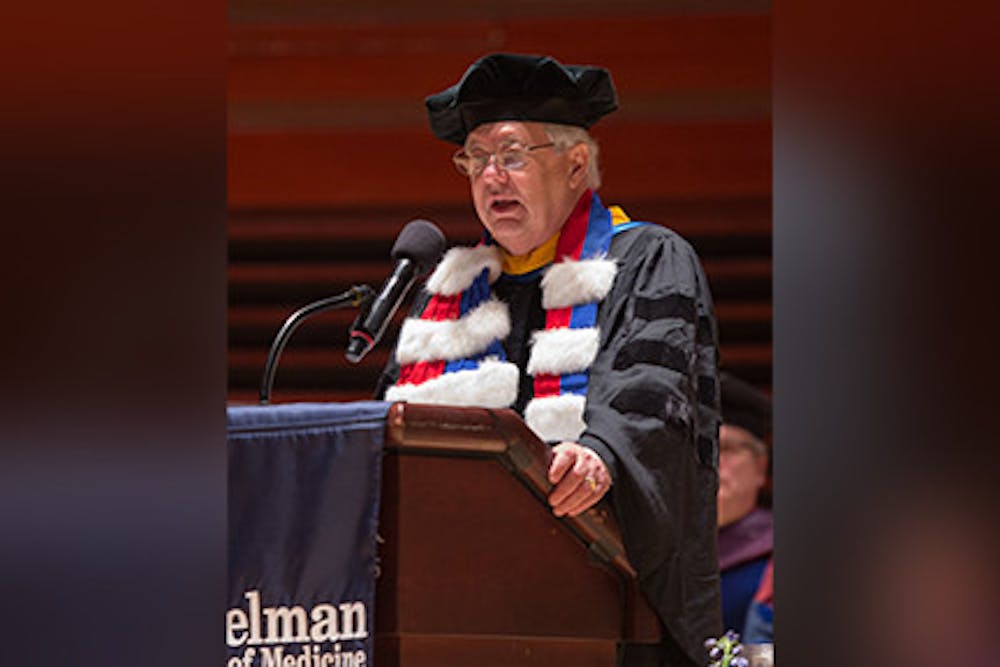
Michael Brown, a Nobel laureate and former editor-in-chief of The Daily Pennsylvanian (Photo from Perelman School of Medicine).
A Nobel laureate and former editor-in-chief of The Daily Pennsylvanian sat down with the DP to reflect on his research and how his time at Penn helped shape his career.
Michael Brown, a 1962 College graduate, stopped by the DP’s office during a visit to campus where he lectured at the Perelman School of Medicine. Brown visited campus to speak in part about winning the Nobel Prize in Physiology or Medicine in 1985 alongside his research partner, Joseph L. Goldstein.
Brown grew up in the Philadelphia suburbs and dreamed from a young age to attend Princeton University. However, he changed his mind after receiving a full scholarship to Penn from Procter & Gamble — which provided a scholarship for two students in each class.
“A man from Procter & Gamble came over to Pennsylvania, and the eight of us scholars were invited for dinner with him,” Brown said. “I was a short, chubby kid at the time, and I saw that the other seven were 6’4” athletes, and I told the dean after that I’d been given the scholarship by mistake.”
Brown studied chemistry in the College but spent most of his time at the DP, beginning as a sports writer, which he believes contributed to his creativity and originality as a scientist.
“Being a sports journalist requires a lot of creativity,” Brown said. “There are only so many times you can say ‘we killed them’, ‘murdered them’, [or ] ‘ruined them.’”
He was soon promoted to the post of special publications editor as part of the DP’s editorial board — the first to consist of female staffers. His board also overcame several struggles with Penn administration.
Brown was editor-in-chief when the University took away the DP's funding following a satire piece on a Penn dean. The publication wrote to other college newspapers and news channels to garner support and coverage, but local television channels declined the DP's request.
To get media coverage and draw support, the DP told students that ere a rally was being organized against the publication, which caused many students to protest.
“After that, we were covered by news channels, and Penn was pressured into giving us our funding back,” Brown added. “However, the dean at the time removed the editor-in-chief and made me editor-in-chief just two weeks before I graduated, even though I was behind the special publication. We released our next paper with the headline, ‘As We Were Saying.’”
After graduating, Brown’s then-girlfriend convinced him to stay in Philadelphia to attend graduate school at the Perelman School of Medicine, where he finished near the top of his class. Brown and his now-wife will celebrate their 60th anniversary next year.
Brown completed his residency at the Massachusetts General Hospital, where he first met Goldstein, his partner in winning the Nobel Prize. Brown, who bonded quickly with Goldstein, described him as one of the smartest people he had ever met.
After their residency, both Goldstein and Brown went on to work at the National Institutes of Health in Bethesda, Md., and found the discovery that would eventually win them the Nobel Prize. Brown described the NIH program as highly competitive, as it offered an escape from being posted in Vietnam during the ongoing war.
During their work for the program, Goldstein and Brown encountered the case of a six-year-old girl with abnormally high levels of cholesterol in her blood. This caused her to have repeated heart attacks — highly unusual behavior for someone of her age. Bypass surgeries and other cholesterol-counter medications were not prevalent then, causing Goldstein and Brown to investigate the matter.
After using cell culture from the girl’s DNA, Brown successfully managed to solubilize and partially refine the previously mysterious enzyme of 3 hydroxy 3 methylglutaryl coenzyme A reductase, which plays a pivotal role as the rate-controlling enzyme in cholesterol biosynthesis.
Brown and Goldstein formulated a theory that irregularities in the control of this enzyme were responsible for familial hypercholesterolemia — a genetic disorder characterized by the accumulation of excessive cholesterol in the bloodstream and tissues. The discovery earned Brown and Goldstein the Nobel Prize, culminating the pair's scientific partnership.
Nearly 40 years later, Brown and Goldstein still work together. Brown currently splits his time in Dallas between his family and lecturing across the United States. He said that winning the Nobel was a reminder of how his time and colleagues at the DP have remained a constant fixture, even today.
"When I won the Nobel, the White House sent me a letter from the Reagan administration, and it was signed by Charles Horner, an old friend of mine from the DP," Brown said.
The Daily Pennsylvanian is an independent, student-run newspaper. Please consider making a donation to support the coverage that shapes the University. Your generosity ensures a future of strong journalism at Penn.
Donate



